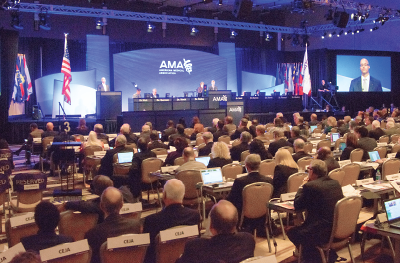The AMA last month called for a ban on direct-to-consumer advertising (DTCA), citing its effect on driving up pharmaceutical prices.
At the Interim Meeting of the AMA’s House of Delegates in Atlanta, delegates who voted for the resolution calling for an end to DTCA said that although some patients may be prompted to visit a physician because of increased awareness of an illness or treatment stemming from advertising, the ultimate goal of DTCA is to drive demand for a product, resulting in increased pharmaceutical prices.
A number of other resolutions and reports at the meeting were devoted to the issue of escalating drug prices. Psychiatrist and AMA Board Chair-elect Patrice Harris, M.D., M.A., said that the vote in support of an advertising ban reflects concerns among physicians about the negative impact of commercially driven promotions and the role that marketing costs play in fueling escalating drug prices.
“Direct-to-consumer advertising also inflates demand for new and more expensive drugs, even when these drugs may not be appropriate,” she said. “Patient care can be compromised and delayed when prescription drugs are unaffordable and subject to coverage limitations by the patient’s health plan. In a worst-case scenario, patients forego necessary treatments when drugs are too expensive.”
The United States and New Zealand are the only two countries in the world that allow DTCA of prescription drugs. Advertising dollars spent by drug makers have increased by 30 percent in the last two years, to $4.5 billion, according to market research by the research firm Kantar Media, cited by the AMA in a statement.
In an interview with Psychiatric News, John McIntyre, M.D., the immediate past chair of the AMA’s Council on Medical Service and a former APA president, said passage of the resolution was a bold and somewhat surprising initiative.
He noted that the House of Delegates has policy recommendations on how such advertising should be conducted dating back to 1999. “Our longstanding policy recommendations are that DTCA should be educating consumers about illnesses and the benefits and potential downsides of treatment, as well as informing consumers about [options other than the advertised product] for treating or managing the condition,” he said. “The latter is rarely if ever done, and ads continue to a large extent ignoring many of the principles the AMA established in 1999 and subsequent years. That combined with escalating drug prices finally led to delegates saying ‘enough is enough.’ Clearly, the intent of advertising is to increase the use of drugs and put pressure from consumers on physicians and the health care system for the products, regardless of whether they are really good or necessary or even harmful.”
Carolyn Robinowitz, M.D., chair of the Section Council on Psychiatry and a former APA president, said many delegates expressed concern that the considerable budgets allocated by pharma for advertising could be better invested in research and development.
McIntyre refuted the claim that a ban on advertising is not possible or would constitute an abridgement of freedom of speech. “The pharmaceutical companies are powerful and will fight heavily to avoid a ban because DTCA works to push up drug sales very significantly,” he said. “If the debate were to be public, the companies will raise claims about free speech.”
He said the existing AMA policy offering recommendations for how DTCA should be conducted still stands and was referred by delegates to the Board of Trustees for a decision to rescind, amend, or retain. Only the Food and Drug Administration, which oversees and regulates advertising for prescription drugs, or Congress has the power to put such a ban in place.
A separate report by the Council on Medical Service calls for the AMA to “generate an advocacy campaign to engage physicians and patients in local and national advocacy initiatives that bring attention to the rising price of prescription drugs and help to put forward solutions to make prescription drugs more affordable for all patients.” A report on the campaign’s progress is expected to be presented at the 2016 Interim Meeting of the House of Delegates in Orlando, Fla.
The council’s report also calls on the AMA to take the following steps:
•
Encourage Federal Trade Commission actions to limit anticompetitive behavior by pharmaceutical companies attempting to reduce competition from generic drug manufacturers through manipulation of patent protections and abuse of regulatory exclusivity incentives.
•
Encourage transparency regarding the cost and price of drugs among pharmaceutical companies, pharmacy benefit managers, and health insurance companies.
•
Support legislation to shorten the patent exclusivity period for biologics.
•
Reaffirm existing policy to support federal legislation that gives the secretary of the Department of Health and Human Services the authority to negotiate contracts with manufacturers of drugs covered under Medicare Part D and work toward eliminating the Medicare prohibition on drug-price negotiation. ■
The AMA resolution and the Council on Medical Service report on pharmaceutical costs can be accessed
here.

